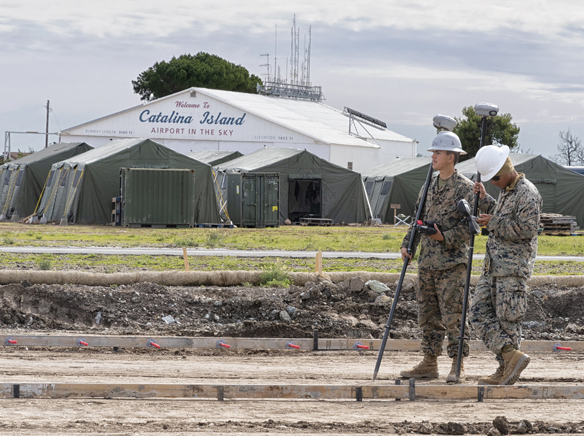
Last week’s celebration marking the completion of Catalina’s decaying 77-year-old airport runway turned out to be the celebration of much more than a new runway, according to senior military officials attending the event.
According to the Marines’ top Innovative Readiness Training program officer, the Airport in the Sky project marked the largest “project of scale” ever performed by active duty troops, but also the first time Marines and U.S. Navy Seabees had worked together to learn each other’s skills.
According to Maj. Lisbeth Andriessen, the largest similar IRT project was the construction of an “expeditionary” runway on Kodiak Island in Alaska, but an expeditionary runway is only made of dirt.
Therefore, the Marines called in the infrastructure-based U.S. Navy Seabees, whose mission it is to build projects like concrete runways, to rebuild the 3,000-foot runway on the newly renamed ACE Clearwater airfield on Catalina’s the Airport in the Sky.
Following a year of fundraising and other government paperwork, Andriessen said about 100 Marines and 50 Navy Seabees began arriving on the island in December 2018 to launch the project.
In earlier times, Andriessen said projects like this would have been built on “government owned land in the dessert” but now the IRT program has discovered the win/win qualities of a public/private partnership such as one now completed on Catalina Island.
The servicemen are required to live in tent cities and exist pretty much as if they were on an island in the Pacific, notwithstanding the fact that Catalina is, in fact, such an island. While the servicemen were granted time off, the nature of the program is that they need to learn how to survive and succeed in field tested environments.
During the construction, Andriessen said the service members literally prepared their own food, lived in tents, constructed community showers and pretty much lived in their own tent cities.
In the end, she said, “the Marines and Seabees get the training and the community gets the project.”
It was no easy feat. The island’s airport sits on land governed by the Santa Catalina Island Conservancy and is called “Airport in the Sky” because it was built at the top to two mountains (approximately 1600 feet high) that were leveled and filled in to create the first runways.
The airport’s main landing strip has required frequent patching, costing the Conservancy about $250,000 a year in labor and materials. The California Department of Transportation’s (Caltrans) Aeronautics Division issues a public use permit for the airport and annually inspects the Airport in the Sky’s runway. Caltrans had told the Conservancy that it needed a long-term repair plan in place by September 2018 to continue to operate the airport as a public airport.
Budrovich has said the project originated more than two years ago when a Navy pilot flying his own plane on his day landed at the airport.
The pilot noticed the runway had a few years on it and asked the Conservancy official if they had ever considered a partnership with the Navy.
For the next 18 months, the Conservancy worked with the Marines and the Navy through the Department of Defense’s Office of the Assistant Secretary of Defense, Navy personnel and the Marine Expeditionary Force to initiate the project.
Following two years of planning, military equipment arrived on Catalina in December 2018. Over 150 Marines and Seabees arrived on Catalina Island and began work in January to perform the training mission, with nearly 200 Marines and Seabees participating throughout the project.
According to an account given by Navy Seabee Lt. Michael Brown, 500 tons of equipment used for the project, truck, supplies, etc. traveled from Miramar Naval Air Station by caravan to the Port of Los Angeles, then over to Two Harbors, from where they were trucked into place through the islands slim and narrow dirt roads.
Overall military units participating included I Marine Expeditionary Force (I MEF) out of Camp Pendleton, 3rd Marine Aircraft Wing (3rd MAW) and Marine Wing Support Squadron 373 (MWSS-373) out of Marine Corps Air Station Miramar, Naval Construction Group One (NCG1), First Naval Construction Regiment (1NCR) and Navy Mobility Construction Battalion (NCMB-25).
Through rain, sleet, wind and cold, the Marines surveyors, construction engineers and heavy equipment operators worked with Navy Seabees eventually pouring and finished more than 120 large slabs of concrete. All told, it was enough concrete to cover 180,000 square feet on the Catalina mountaintop (60 feet wide by 3200 feet long).
There was much pride among the servicemembers as Marines lined the runway and others cheered as a DC-3 once owned by Philip K. Wrigley circled the field before finally becoming the first to touch down on their very hard handiwork.
Lt. Col. James Bauch, commanding officer to the Marine Wing Support Squadron 373 said overall, the project went better than expected, giving the Marines invaluable experience and knowledge of having to think about how get the equipment on the island and learning how to succeed with little or no supporting infrastructure.
As key officials from around the state looked on with pride, Budrovich said the overall effort was a win/win for the Conservancy and the military IRT program, setting the stage for next 100 years of air connections to Catalina.









